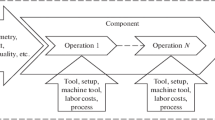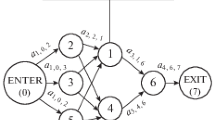Abstract
An economic frameword for evaluting flexible integrated circuit manufacturing technologies is developed as an alternative to the capacity races that appear to have played a major role in the decline of the U.S. IC industry. Economic advantages of flexible IC manufacturing technologies (such as cluster tools and multiprocessors) may include reductions in units costs at low output volumes, inexpensive increases in the diversity of IC products manufactured, and acceleration of the speed of new product introduction. The consequences of these developments for semiconductor equipment producers, IC manufacturers, and electronic system producers are examined.
Similar content being viewed by others
References
Bernheim B. Douglas and Shoven John B. (1989) ‘Comparison of the cost of capital in the U.S. and Japan: the roles of risk and taxes’, CEPR Technical Paper 179, Stanford, Center for Economic Policy Research, September.
Borrus Michael A. (1988) Competing for Control: America's Stake in Microelectronics, Cambridge, Mass.; Ballinger.
Chandler Alfred (1990) Scale and Scope, Cambridge, Mass., Harvard University Press.
Deineger C. Richard (1990) ‘Fabs of the year 2000’, processed, Austin, Texas, Advanced Micro Devices.
Flaherty M. Therese and Itami Hiroyuki (1984) ‘Finance’, in Daniel I. Okimoto, Takuo Sugano, and Franklin B. Weinstein (eds.), Competitive Edge: The Semiconductor Industry in the U.S. and Japan, pp. 134–176, Stanford, Stanford University Press.
Flamm, Kenneth (1991) ‘Making new rules: High-tech trade friction and the semiconductor industry’, The Brookings Review, Spring, pp. 22–29.
McIvor Robert (1989) Manufacturing for Profit in the Semiconductor Industry, New York, Prentice Hall.
Okimoto Daniel I. (1984) ‘Background’, in Daniel I. Okimoto, Takuo Sugano, and Franklin B. Weinstein (eds.), Competitive Edge: The Semiconductor Industry in the U.S. and Japan, pp. 9–34, Stanford, Stanford University Press.
Prestowitz Clyde V. (1988) Trading Places: How We Allowed Japan to Take the Lead, New York; Basic Books.
Steinmueller, W. Edward (1988a) ‘U.S. and Japanese policy toward the IC industry’, in John B. Shoven (ed.), Government Policies Toward Industry in the U.S. and Japan, pp. 319–354, Cambridge University Press.
Steinmueller W. Edward (1988b) ‘International joint ventures in the integrated circuit industry’, in David C. Mowery (ed.), International Collaborative Ventures in U.S. Manufacturing, pp. 111–145, Cambridge, Mass, Ballinger.
Strojwas Andrzej and Director Stephen W. (1988) ‘The process engineer's workbench’, IEEE Journal of Solid-State Circuits, SC 23(2), 377–386.
Technecon Analytic Research, Inc. (1991) ‘The impact of the 1986 U.S.-Japan semiconductor agreement on DRAM prices’, (Prepared for the Semiconductor Industry Association), Washington, D.C., January.
Wood, Samuel C. (1988) ‘Single wafer multiprocessors’, processed, Center for Integrated Systems, Stanford University.
Wood, Samuel C. and Saraswat, Krishna (1991a), ‘Modeling the Performance of Cluster-based Fabs,’ IEEE, Third Annual International Semiconductor Manufacturing Science Symposium, pp. 8–14, May 21–23.
Wood, Samuel C. and Saraswat, Krishna (1991b), ‘Factors affecting the economic performance of cluster-based fabs,’ Proceedings, Electrochemical Society Third International Symposium on ULSI Science and Technology, pp. 551–565, April 11.
Author information
Authors and Affiliations
Additional information
Research support from the Center for Integrated Systems, Stanford University sponsored by DARPA, the United States Air Force/TI MMST Program and the Center for Economic Policy Research, Stanford University is gratefully acknowledged. I have profited from comments by Paul Losleben, Philip Webre, Krishna Saraswat, F. M. Scherer, and Sam Wood.
Rights and permissions
About this article
Cite this article
Steinmueller, W.E. The economics of flexible integrated circuit manufacturing technology. Review of Industrial Organization 7, 327–349 (1992). https://doi.org/10.1007/BF00353399
Issue Date:
DOI: https://doi.org/10.1007/BF00353399




